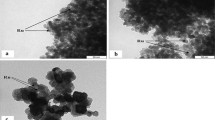Abstract
Hydro-electric plasma technology in the presence of TiO2 catalyst used to treat 2,4-dinitrophenol (2,4-DNP) simulated wastewater is reported. The catalytic activity of TiO2 prepared by ammonia precipitation was greater than the activity of the TiO2 prepared by NaOH precipitation. The presence of chloride ions during the preparation process of TiO2 had a large negative effect on the catalytic activity. The catalytic activity of TiO2 calcined at 673 K was significantly higher than the activity of the TiO2 that was calcined at higher and lower temperatures. After being calcined at 673 K, TiO2 was mainly in the anatase phase and degraded 81% of the 2,4-DNP after 10 min of treatment.




Similar content being viewed by others
References
Clements JS, Sato M, Davis RH (1987) Preliminary investigation of prebreakdown phenomena and chemical reactions using a pulsed high-voltage discharge in water. IEEE Trans Ind Appl IA-23:224–235
Grymonpre DR, Finney WC, Clark RJ, Locke BR (2004) Hybrid gas-liquid electrical discharge reactors for organic compound degradation. Ind Eng Chem Res 43:1975–1989
Hao X-L, Zhou M-H, Zhang Y, Lei L-C (2006) Enhanced degradation of organic pollutant 4-chlorophenol in water by non-thermal plasma process with TiO2. Plasma Chem Plasma Process 26:455–468
Hao X, Zhou M, Xin Q, Lei L (2007a) Pulsed discharge plasma induced Fenton-like reactions for the enhancement of the degradation of 4-chlorophenol in water. Chemosphere 66:2185–2192
Hao XL, Zhou MH, Lei LC (2007b) Non-thermal plasma-induced photocatalytic degradation of 4-chlorophenol in water. J Hazard Mater 141:475–482
Hirooka T, Nagase H, Hirata K, Miyamoto K (2006) Degradation of 2,4-dinitrophenol by a mixed culture of photoautotrophic microorganisms. Biochem Eng J 29:157–162. doi: 10.1016/j.bej.2005.03.018
Hsiao C-Y, Lee C-L, Ollis DF (1983) Heterogeneous photocatalysis: degradation of dilute solutions of dichloromethane (CH2Cl2), chloroform (CHCl3), and carbon tetrachloride (CCl4) with illuminated TiO2 photocatalyst. J Catal 82:418–423
Gao J, Liu Y, Yang W, Pu L, Yu J, Lu Q (2003) Oxidative degradation of phenol in aqueous electrolyte induced by plasma from a direct glow discharge. Plasma Sources Sci Technol 12:533–538
Li J, Zhou Z, Wang H, Li G, Wu Y (2007) Research on decoloration of dye wastewater by combination of pulsed discharge plasma and TiO2 nanoparticles. Desalination 212:123–128
Lukes P, Clupek M, Sunka P, Peterka F, Sano T, Negishi N, Matsuzawa S, Takeuchi K (2005) Degradation of phenol by underwater pulsed corona discharge in combination with TiO2 photocatalysis. Res Chem Intermed 31:285–294
Sato M, Ohgiyama T, Clements JS (1996) Formation of chemical species and their effects on microorganisms using a pulsed high-voltage discharge in water. IEEE Trans Ind Appl 32:106–112
Sun B, Sato M, Clements JS (2000) Oxidative processes occurring when pulsed high voltage discharges degrade phenol in aqueous solution. Environ Sci Technol 34:509–513
Toma FL, Bertrand G, Klein D, Coddet C (2004) Photocatalytic removal of nitrogen oxides via titanium dioxide. Environ Chem Lett 2:117–121. doi: 10.1007/s10311-004-0087-2
Vera Perez I, Rogak S, Branion R (2004) Supercritical water oxidation of phenol and 2,4-dinitrophenol. J Supercrit Fluids 30:71–87. doi: 10.1016/S0896-8446(03)00166-9
Wang H, Li J, Quan X, Wu Y, Li G, Wang F (2007) Formation of hydrogen peroxide and degradation of phenol in synergistic system of pulsed corona discharge combined with TiO2 photocatalysis. J Hazard Mater 141:336–343
Acknowledgments
The project was supported by National Nature Science Funds of China (No. 20466001), Guangxi University Key Program for Science and Technology Research (No. 2004ZD01) and Guangzhou Education Office Scientific Research Projects (62040). Also, we thank Dr. Donald Barnes, Visiting Professor of Chemistry at Guangxi University for his helpful discussions about this paper.
Author information
Authors and Affiliations
Corresponding author
Rights and permissions
About this article
Cite this article
Qin, Z.Z., Liu, Z.L., Zeng, Y.F. et al. The effects of different methods of catalyst preparation on the hydro-electric plasma TiO2-catalyzed degradation of 2,4-dinitrophenol. Environ Chem Lett 7, 149–153 (2009). https://doi.org/10.1007/s10311-008-0150-5
Received:
Accepted:
Published:
Issue Date:
DOI: https://doi.org/10.1007/s10311-008-0150-5




